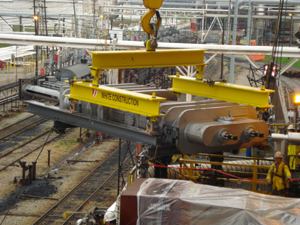
Home | Engineering Services | Research | SC&RA Jobs of the Year | Publications | About David Duerr, P.E. (ret.)
Below-the-Hook Lifting Devices - Engineering Research

David Duerr, P.E. (ret.) has been designing below-the-hook (BTH) lifting devices since his earliest days in the rigging business in the mid-1970s. These lifters have ranged from the simplest spreader bars to complex devices with powered swivels and in capacities from just a few tons to over 1,000 tons. He serves on the ASME B30.20 Subcommittee and on the ASME BTH Committee since its inception (as chair from 2006 to 2012 and as vice chair from 2012 to 2018).
The current ASME below-the-hook lifting device standards are available here:
Shortly after the publication of the first (2005) edition of BTH-1 Design of Below-the-Hook Lifting Devices, Mr. Duerr wrote five papers that were published in the ASCE Practice Periodical on Structural Design and Construction. These papers provide BTH-1 users with additional details about the background of the standard, designed to help users better understand its provisions.
ASCE Practice Periodical on Structural Design and Construction papers published in 2007 and 2008:
"New Standard for Design of Below-the-Hook Lifting Devices"
"Design Category and Service Class Selection for Below-the-Hook Lifting Devices"
"Design Factors for Fabricated Steel Below-the-Hook Lifting Devices"
"ASME BTH-1 Pinned Connection Design Provisions"
"Design of Stiffened Plate Lifting Beams"
While the first edition of BTH-1 was well received, informal questions and requests for interpretation received from users of the standard showed that work remained to be done. Subsequent editions of BTH-1 (2008, 2011, 2014, 2017, and 2020) refined and clarified the structural, mechanical and electrical design requirements and added a new chapter applicable to lifting magnets.
The commentary for Chapter 3 of ASME BTH-1, found in Nonmandatory Appendix C, cites two papers written by Mr. Duerr that provide the technical basis for certain provisions of the standard.
The pinned connection design provisions in BTH-1 are quite different than those found in the more familiar AISC Specification for Structural Steel Buildings. The more detailed BTH-1 provisions are appropriate, given the importance of pinned connections in lifting devices and the ways that pinned connections are detailed. The paper "Pinned Connection Strength and Behavior" provides details about the research that underlies these provisions in BTH-1. This paper is also referenced in the pinned connection paper in the list at left.
The elastic lateral-torsional buckling behavior of suspended beams differs from that of beams that are framed into a structure. This behavior must be accounted for in the design of lifting beams. The paper "Lateral-Torsional Buckling of Suspended I-Shape Lifting Beams" explains the derivation of the lateral-torsional buckling strength coefficient CLTB used in the BTH-1 beam design equations for I-shape beams.
A third paper, not referenced in BTH-1, "Lateral-Torsional Buckling of Suspended Tee-Shape and Flat Plate Lifting Beams" expands the material reported in the paper cited above to cover tee-shape and flat plate beams. This paper demonstrates the performance of the CLTB equations in BTH-1 for these types of beams.
Copyright © 2DM Associates, Inc. 2025. All rights
reserved.
As of October 1, 2019, 2DM Associates, Inc. is no longer
providing professional engineering services.